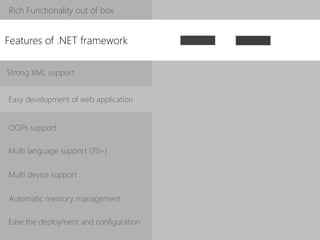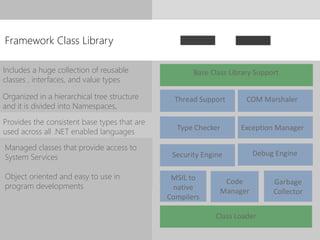.Net
- 1. Microsoft® .NET framework Presented by: Vignesh K Nair Sreekutty P S Powered by CLEMENTIA Microsoft .NET
- 2. What is not? Simply it is the technology from Microsoft, on which all other Microsoft technologies will be depending on in future. ■ It is a platform neutral framework. ■ provides a common set of class libraries ■ supports many programming languages, including VB.NET, C# etc. ■ layer between the operating system and the programming language. .NET Application .NET Framework OS + Hardware What is .NET ? Not an OS Not an Intermediate Language Not a Compiler alone Not a PL Not a SW Not an Emulator
- 3. Language supports Microsoft VB C++ C# Python Pascal COBOL APL Oberon Java Script Java J# Perl Haskell Eiffel Small Talk
- 4. Features of .NET framework Strong XML support Easy development of web application OOPs support Multi language support (70+) Multi device support Automatic memory management Ease the deployment and configuration Rich Functionality out of box
- 5. Components of .NET framework Common Language Runtime (CLR) Common Language Specification (CLS) Framework Class Library (FCL) Just in Time Compiler (JIT) Common Type System (CTS)
- 6. Common Language Runtime Core of .NET platform Language independent Environment Manages Thread execution ,Memory &Garbage collection VB. NET C# C# complier Microsoft Intermediate Language(MSIL) VB.NET compiler Common Language Runtime (CLR) JIT(Just In Time)Compiler Native Code Simplifies Application Development Access to metadata Enforcement of code access security Automation of object layout
- 7. Common Language Specification Common level of language functionality Set of rules that a language compiler must adhere Enables the creation of a club of CLS compliant languages Defines Types allowed on external calls C# Common Language Specification .NET framework javaJ#Visual Basic C++ Actually a set of restrictions on the CTS Describes the executable code and runtime environment
- 8. Framework Class Library Includes a huge collection of reusable classes , interfaces, and value types Organized in a hierarchical tree structure and it is divided into Namespaces. Provides the consistent base types that are used across all .NET enabled languages Managed classes that provide access to System Services Object oriented and easy to use in program developments Base Class Library Support Thread Support COM Marshaler Type Checker Security Engine Exception Manager Debug Engine MSIL to native Compilers Code Manager Garbage Collector Class Loader
- 9. Advantages of .NET Framework ‚ù∂Consistent programming model :With .NET accessing data with a C# and VB.NET very similar apart from slight syntactical differences. Both the programs need to import the System. Data namespace, both programs establish connection with database and both programs run a query and display the data. ‚ù∑Direct Support for Security : .NET framework enables the developer and the system administrator to specify method level security. ‚ù∏Simplified Development efforts: The .NET Framework simplifies debugging with support for Runtime diagnostics. ‚ùπEasy application deployment and Maintenance : The .NET Framework makes easy to deploy applications. The .NET Framework handles the details of locating and loads the components. ‚ù∫Assemblies : Assembly is elementary unit in a framework application. It performs various functions in programming with the .NET Frame work. Every computer that has the .NET Framework installed with have the Global Assembly Cache.
- 10. https://We are ready to answer you… ANY QUESTIONS?? << >>
- 11. THANK YOU











